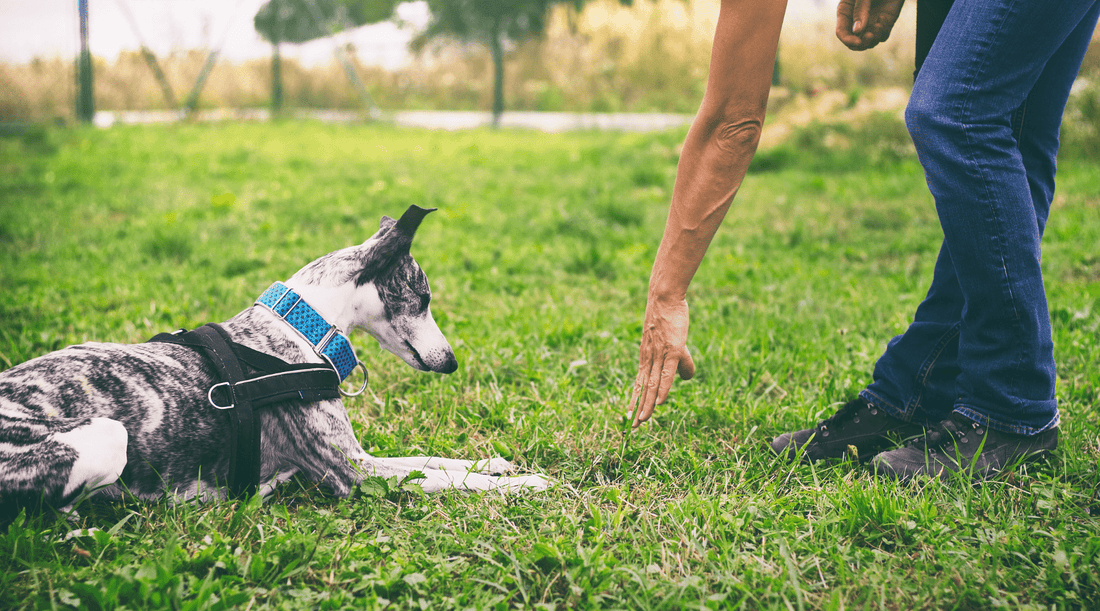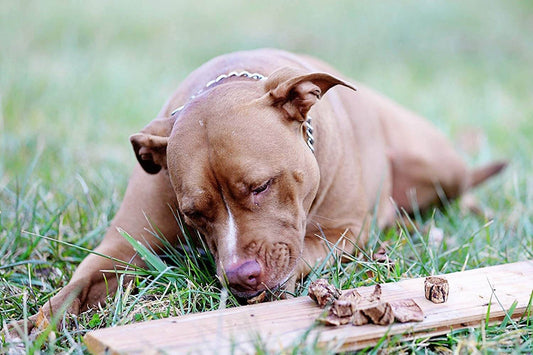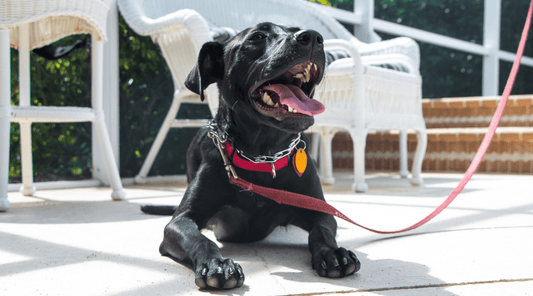
How to Teach a Dog to Lay Down (This Calms a Dog Down Fast)
Dawn Miller Apr 22, 20255 Minute ReadSaturday morning in our neighborhood usually starts with the chorus of barking dogs, leaf blowers, and the occasional squirrel chase gone sideways.
This week, it was Aslan—the Goldendoodle from two doors down—who got a little too excited about a squirrel and yanked poor Janet straight into a bush.
No harm done (to Janet or the bush). But it reminded me how useful the “lay down” command is—especially when your pup’s brain flips into chase mode.
Teaching a dog to lay down is more than a cute party trick. It’s one of those foundational commands that calms your dog, builds their focus, and sets you both up for bigger wins—like off-leash walks on the trail or relaxed vet visits.
Why “Lay Down” Is an Essential Dog Command
When I say essential dog command, you might think "sit" or "stay". But I'll make the case that lay down could be even more important.
While sit is a polite hello for a dog, lay down is more like let's all take a deep breath.
Teaching your dog to lie down helps:
- Settle excitement instantly (looking at you, Aslan)
- Ease anxiety in new environments
- Redirect attention away from distractions
- Strengthen impulse control
- Ready a dog for a checkup (at home or the vet)
Lying down is a naturally restful position that signals to your dog’s nervous system: “You’re safe. You can relax now.”
Now, before I go any further, I want to address the elephant in the room for many of us English majors out there. If you want to say "lie down" instead of lay down, because it's grammatically correct, please, do that. I have intentionally chosen to say "lay down" for this topic because language is constantly evolving....and lay down is currently overtaking lie down in everyday speech.
Moving on...
Before You Start
Dog training requires the right tools. Here are some that will make this 10X easier.
- High-value dog treats (I use K9 Connoisseur beef lung bites. They're irresistible and nutritious.)
- A leash (optional) for structure if your dog runs around
- Patience (lots of it)
- A quiet space to minimize distractions
🐾 Pro tip: Use a long-lasting dog bone or chew after training to help your dog unwind and reinforce calm behavior.
How to Teach a Dog to Lay Down
Step 1: Lure Them Low
The nose is a dog's primary connection to the world. Most dogs naturally follow food with their noses.
That’s your superpower. Use a treat to guide your dog into position.
- Start with your dog in a sitting position. If they don't know "sit", teach them that first. It takes all of 5 minutes with positive reinforcement dog training.
- Hold a Dog Treat in front of their nose.
- Slowly move the treat down toward the floor, in a straight line between their front paws.
- If they follow it down with their body—praise and treat right away!
Imagine drawing an “L” with the treat. Straight down, then out. Most dogs will lie down to reach it.
If your dog won’t lay down, don’t push. Just bring them back to sit and try again with slower motion or more encouragement in your voice.
Step 2: Add the Cue
Once your dog starts dropping into a down position consistently, pair it with a verbal command.
You can say:
- “Down”
- “Lay down”
- "Lie down"
- Or even something fun like “Settle” or “Chill” or "Simmer Down" if that's your vibe.
Consistency matters, though. So, once you choose one, that's it.
Guide them to the ground, say the cue, and reward with a high-value treat and praise.
Step 3: Add a Hand Signal
Adding a hand signal helps them remember faster. And you never know when you might need to instruct your dog to lie down in the presence of a leafblower.
Try this: flatten your hand and move it slowly downward, like you're pressing an invisible game show buzzer in slow-mo.
Over time, your dog will respond to just the gesture, even in noisy or crowded places.
Step 4: Practice in Short Sessions
Training works best in tiny bursts—5 to 10 minutes max. Especially if your dog is a puppy or easily distracted.
When I first started training my distractible terrier, I was lucky if she gave me 2 minutes. With practice, and some focus-promoting marrow-bone sessions, we worked our way up to 10 minutes. And sometimes, we get to 15 and she's like, don't stop now. I'm on a roll.
But 10 minutes really is a very productive amount of time for a dog training session.
Set a timer if you have to. End every session with something they know (like “sit”) and a celebration—a dog bone treat and a happy tone.
That way, your dog builds positive associations with training time and wants to do it again tomorrow.
Step 5: Generalize the Behavior
Dogs are notorious for thinking a command only applies in a particular setting, like your living room. So, it's essential to use the command in several places and situations.
- Backyard
- Park
- On the sidewalk (that's important if you need to instantly stop a chipmunk chasing challenge)
- At a neighbor's house
- At the vet
- In the car
- At the dog-friendly cafe
- Around children
Once they consistently perform the skill in 3-4 places, they'll understand that "lay down" means lay down, no matter where they are or who they're around.
Each time you reward this behavior, your dog builds confidence that they understand what "Lay Down" means.
Dog Won't Lay Down...Now What?
Some dogs are more reluctant to lie down, especially in unfamiliar places, due to:
- Past trauma
- Physical discomfort (like arthritis, obesity, or other dog health problems)
- Nervousness
Empathize as you figure out what the barrier is. Here are some dog training tips that often work with a dog that won't lay down.
Try training on a soft mat or rug to make it more comfortable. If they still resist, back up to easier commands, and sprinkle in lay-down practice when they’re relaxed.
Consider adding natural joint supplements if you think they might have early joint pain. Enhance their nutrition and overall dog health with high-value dog treats.
Give them a dog bone as a more substantial treat, but only if they lie down. Dog bones can help nervous dogs relax.
And of course—never force them into position. That breaks trust, and trust is the bedrock of good dog training.
How to Calm a Dog
Lying down isn’t just physical—it’s emotional. Teaching this command builds confidence, structure, and clarity. It helps dogs know what to do, not just what not to do.
So, if your dog is pacing during a thunderstorm, barking at the kids playing across the street, or otherwise showcasing signs of stress, tell them to "lay down" in a cheerful voice. It's like asking a friend experiencing anxiety to take some deep breaths with you. It works!
Pair that with positive reinforcement, a cheerful tone, and healthy routines, and you’ll start seeing a more relaxed pup in all areas of life.
And if you want extra support, join our 7-Day Dog Training Challenge. You’ll get daily videos, helpful tips, and all the guidance you need to turn your dog into a focused, well-mannered training rockstar.
👉 Start the Training Challenge
Available On:


Disclosure: This article may contain affiliate links, which means we may earn a small commission if you make a purchase through these links—at no extra cost to you. We only recommend products we trust and believe will benefit you and your K9.



